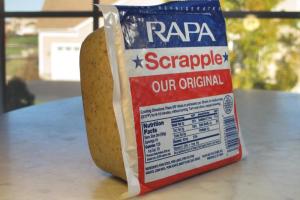The team at Southern Delaware Tourism asked me to share with you their trademarked label for our region, the Culinary Coast. Many of us chose to live here because of the lure of Delaware’s beautiful beaches, but we also appreciate the vast array of dining opportunities offered by our vibrant restaurant scene. From quality local ingredients to the skills of talented chefs, brewers, and vintners, we’re able to enjoy Southern Delaware’s Culinary Coast.
In addition to creative combinations concocted at restaurants every day, another aspect of the Culinary Coast is our rich food history and foodways traditions. One of the more complicated and controversial conversations about food will always arise if the subject is scrapple. Scrapple is one of those foods people either love or hate or have never tried because of the daunting ingredient list.
What exactly is scrapple? Basically, it’s a meat-infused broth cooked with a thickening ingredient and spices to become mush. This is poured into loaf pans and either baked or allowed to become firm in the refrigerator. Scrapple is usually served as a breakfast meat: thin slices are carved from the loaf and browned in melted fat or butter until crisp.
The original creation of scrapple can be traced back to farmers who raised pigs for food. Once the pigs were butchered and the various pieces sent to the smokehouse, anything leftover, especially the less desirable cuts or scraps and specifically the organ meats were not wasted, but used to make this filling breakfast treat. Most food historians believe the dish dates back to the 1600s in Germany where it originally was called panhas, pawnhos, or pan haas, which translates to '"pan rabbit.”
The concept behind scrapple (everything but the oink) has variations based on geography. For example, the Pennsylvania version uses pork, buckwheat and cornmeal, sliced, fried, and served with maple syrup. In Northern Kentucky and Cincinnati, their version of the dish is called goetta (pronounced “Get-uh”) which uses both beef and pork scraps mixed with steel-cut oats, onions, and spices.
Here in Southern Delaware, there are a number of companies producing our version of scrapple with pork, cornmeal and a secret set of spices that engender a loyal following. The familiar red and blue package of scrapple comes from Bridgeville, Delaware where RAPA was founded in 1926 by Ralph and Paul Adams. Their product line now includes a hot and spicy variety for a more exciting breakfast meat.
In 1863, Isaac S. Habbersett opened Habbersett Pork Products in Middletown, Pennsylvania to become the first company to mass-produce scrapple. Today, their products come from the RAPA plant in Bridgeville, but the label still reads “Philadelphia’s Favorite.” Their product line has expanded beyond pork to include both beef and turkey scrapple. Another brand coming from RAPA in Bridgeville is Greensboro, which features Made in Delaware on their package and adds beef trim to their ingredient list.
Although named Milton Scrapple, Kirby and Holloway produce this Old Homemade Brand in Harrington. The other scrapple brand from our region is Hughes, from Felton. Unlike their competitors who don’t list which specific spices are in the mix, their label includes “sage,” always a winner to combine with pork.
Fans of scrapple are certainly out there. The population of tiny Bridgeville increases by over 25,000 when the Apple Scrapple Festival is held. This year it begins on Friday, October 11, 2024 with the Little Miss Apple Scrapple Pageant. The following day opens at 9 a.m. with an array of crafters, vendors, musical acts, and lots of chances to buy all things apple and scrapple - just another adventure on Southern Delaware’s Culinary Coast.
Scrapple
1 lb fatty cut of pork (jowls or shoulder)
1 lb pork liver
1 1/2 qts water
2 bay leaves
10 whole peppercorns
3 T salt
2 t dried sage
1 t ground coriander
2 t pepper
3 C cornmeal
Combine pork, water, bay leaves and peppercorns in a large saucepan. Heat just to a boil, then reduce heat to a simmer. Braise until completely tender, about 2 1/2 hours.
Once the meat is cooked, remove from heat and allow to cool to room temperature. Strain and reserve the broth; set aside. Grind the cooked meat in a food processor and place in a skillet with the reserved broth. Add remaining ingredients and cook over medium low until a thick mush form, about 15 minutes. Line two loaf pans with parchment paper and spoon the mush into the pans, packing tightly. Refrigerate until firm before using or freezing. To serve, cut a slice about 3/8-inch thick and pan fry on both ides in butter or lard until golden brown.
Scrapple Breakfast Casserole
1 T butter
1 chopped onion
3 C shredded potatoes
1 lb scrapple
8 eggs
2 C shredded cheddar cheese
1 1/2 C shredded Jack cheese
1/4 t white pepper
1 T Parmesan
Preheat oven to 350F. Coat the inside of a 9- by 13-inch baking dish with nonstick cooking spray; set aside. Melt butter in a skillet. Add onion and sauté until translucent. Add potatoes and continue cooking until softened, about 5 to 8 minutes. Transfer potatoes to prepared baking pan. Add scrapple to skillet and cook until starting to crisp, breaking up into small pieces with a spatula. Transfer to baking pan and stir to mix with potatoes. In a large bowl, whisk eggs until smooth; stir in Cheddar, Jack cheese, and pepper. Pour over scrapple mixture and sprinkle with parmesan. Bake until set, about 45 minutes. Allow to rest for 10 minutes before serving. Yield: 4 to 6 servings.


















































